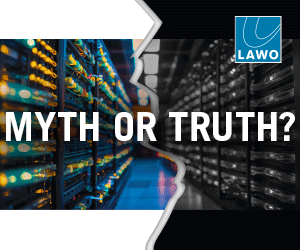The broadcast and video production industry is yet to see the full benefits of cloud-based service provision largely due to bandwidth/cost constraints associated with storing, moving and processing large video files. Julian Wright of BLM suggests that a hybrid model in which the media asset management (MAM) function is provisioned in the cloud and video […]
 The broadcast and video production industry is yet to see the full benefits of cloud-based service provision largely due to bandwidth/cost constraints associated with storing, moving and processing large video files. Julian Wright of BLM suggests that a hybrid model in which the media asset management (MAM) function is provisioned in the cloud and video processing is kept on the ground may be the answer.
The broadcast and video production industry is yet to see the full benefits of cloud-based service provision largely due to bandwidth/cost constraints associated with storing, moving and processing large video files. Julian Wright of BLM suggests that a hybrid model in which the media asset management (MAM) function is provisioned in the cloud and video processing is kept on the ground may be the answer.
Cloud computing the provision of computing as a service rather than as a product has become extremely popular in recent years and has brought with it new business models for vendors and cost models for users. Cloud computing has enabled a pay-per-use model to be employed for many computing functions. Common examples include content repositories, complete with asset management functionality, for storing, searching and retrieving office documents. A business may chose to pay a recurring fee for access to the system and an incremental fee for the storage space required for the content rather than purchasing these components outright.
By making the content accessible through a web browser or through thin client applications communicating through open web service protocols, a business may reduce its reliance on in-house hardware and software and the staff to maintain them.
Another much-touted benefit of the cloud is on-demand pay-per-use storage but, again, what works well for a business that has documents to store doesnt really work for a business where the content that needs to be stored is long-form video. Certainly, for long-term archive storage, the cloud model makes little sense when compared to an in-house storage solution with an LTO or disk-based deep archive in place.
It is also a fact that moving video content from a production office or location to the cloud for processing (e.g. editing, rendering, transcoding or reformatting) and back again is cost prohibitive. The bandwidth requirement, particularly for HD content, is so expensive that there is little or no saving over a short period if compared with buying expensive signal processing software outright and deploying it at the production facility.
MAM is demanding careful consideration as an operational or business strategy rather than as a product from a vendor. A MAM system should complement the needs of the business operation and bring otherwise disparate processing and management systems together. MAM is increasingly thought of as the overarching management interface that brings together a number of smaller systems. In response to this, a number of (relatively) new suppliers have emerged who appreciate that flexibility is paramount and that business requirements set the technical solution, not the other way around.
Most modern MAMs are built on standard relational databases and use web service based technology for communication with client applications as well as interactions with production video processing components and the storage arrays they are managing. By utilising open standards, long-standing interoperability issues are disappearing and the mantras of scalability, flexibility and distributed service-based architectures are being realised.
In a deployed (at the broadcast or production facility) system, a MAM is likely to be physically separate and technically loosely coupled from the video processing and storage components it manages. A natural progression might be to move the MAM into the cloud while leaving the media content within the broadcasters facility. If that is coupled with the movement of low resolution browse media to the cloud a number of operational and commercial opportunities become achievable.
By hosting the MAM and browse essence in the cloud, the true power of the cloud and the real value of the content can be exploited. Operationally, the reach becomes global with users able to perform day-to-day operations that previously had them bound to an office. Content review and approval is typical but that can be extended to subtitling, translation, editing and logging with ease. Web/browser-based content logging for uncatalogued archive material isnt a new idea – services have run in Europe for some years but these have been limited to the context of a service provider offering cataloguing services to an archive content owner. This could be taken a step further by making a watermarked browse version of content publically available and utilising crowdsourcing to enrich the essence metadata. The collective wisdom of the crowd which is self-regulating with open forum peer review or outright voting would ensure accuracy, is very low cost and wiki (fast).
Such an approach could transform the shape of MAM for broadcast content both technically and from a user experience perspective, but not necessarily in a bad way. Doesnt it seem slightly perverse that an operator sitting in a news room is likely to find an item of archive footage quicker using a public Google search than via the in-house archive library? Wouldnt it be useful if a full resolution sub-clip of that content could be restored and delivered, electronically, to my facility in time to edit a package for the evening bulletin? Id pay good money for service like that.
The longtail value of content will always be extended and the infrastructure ROI protracted, but by posting the catalogue on-line and providing a simple mechanism to search, select, retrieve and deliver will ensure that accessibility isnt the barrier. Here, the low, incremental cost, low maintenance overhead and rapidly scalable capabilities of cloud service provision mean that a low capital cost shop window for content could be readily established.
In practice, most operational functions would take place in the cloud with users accessing the content catalogue over the public, or secure, Internet. The search, content browse, content selection as well as billing and CRM systems could also be hosted. If a restore of content is requested then orchestration would also be managed from the asset manager in the cloud but would be executed with the tools located at the broadcast facility.
In this hybrid solution, where the asset management layer sits in the cloud and the large form master content sits securely in the facility, the cost model begins to look attractive enough to drive such initiatives. Low cost scalable cloud for browse content and management, facility internet bandwidth requirement set for content fulfilment/delivery and known and incremental storage costs for master assets all add up to a cost-effective whole.
The last pieces of the puzzle are the software systems that still need to be deployed, owned and maintained on the ground, in this case the pay-per-use benefits yield from the cloud and the scalable basis of deep archive storage systems are nullified, certainly in the short term. Over the summer of 2012, BLM will make a series of announcements about our metered pay-per-use service provision. Broadcasters and content owners will be able to deploy our high quality video processing software at their facility and pay only for the time it is used. A cost model with per minute billing resolution will act as an enabler for some of the notions above and a content owners MAM and distribution channel may come down to a cloud and a crowd.
Julian Wright is the new CEO of Blue Lucy Media. He previously worked at Sky News Arabia as launch programme director.











































































